America’s older population is in the midst of unprecedented growth, but the country is not prepared to meet the housing needs of this aging group, concludes a new report released by the Harvard Joint Center for Housing Studies and AARP Foundation.
According to Housing America’s Older Adults—Meeting the Needs of An Aging Population, the number of adults in the U.S. aged 50 and over is expected to grow to 132 million by 2030, an increase of more than 70% since 2000. But housing that is affordable, physically accessible, well-located, and coordinated with supports and services is in too short supply.
Housing is critical to quality of life for people of all ages, but especially for older adults. High housing costs currently force a third of adults 50 and over—including 37% of those 80 and over—to pay more than 30% of their income for homes that may or may not fit their needs, forcing them to cut back on food, healthcare, and, for those 50-64, retirement savings.
Much of the nation’s housing inventory also lacks basic accessibility features (such as no-step entries, extra-wide doorways, and lever-style door and faucet handles), preventing older persons with disabilities from living safely and comfortably in their homes. Additionally, with a majority of older adults aging in car-dependent suburban and rural locations, transportation and pedestrian infrastructure is generally ill-suited to those who aren’t able to drive, which can isolate them from friends and family.
Finally, disconnects between housing programs and the healthcare system put many older adults with disabilities or long-term care needs at risk of premature institutionalization.
“Recognizing the implications of this profound demographic shift and taking immediate steps to address these issues is vital to our national standard of living,” says Chris Herbert, acting managing director of the Harvard Joint Center for Housing Studies. “While it is ultimately up to individuals and their families to plan for future housing needs, it is also incumbent upon policy makers at all levels of government to see that affordable, appropriate housing, as well as supports for long-term aging in the community, are available for older adults across the income spectrum.”
Of special concern as the older population in the U.S. continues to swell are the younger baby boomers who are now in their 50s. With lower incomes, wealth, homeownership rates, and more debt than generations before them, members of this large age group may be unable to cover the costs of appropriate housing or long-term care in their retirement years.
Indeed, while a majority of people over 45 would like to stay in their current residences as long as possible, estimates indicate that 70% of those who reach the age of 65 will eventually need some form of long-term care. In this regard, older homeowners are in a better position than older renters when they retire. The typical homeowner age 65 and over has enough wealth to cover the costs of in-home assistance for nearly nine years or assisted living for six and half years. The typical renter, however, can only afford two months of these supports.
“As Americans age, the need for safe and affordable housing options becomes even more critical,” says Lisa Marsh Ryerson, President of the AARP Foundation. “High housing costs, aging homes, and costly repairs can greatly impact those with limited incomes. The goal in our support of this report is to address the most critical needs of these households and it is AARP Foundation’s aim to provide the tools and resources to help them meet these needs now and in the future.”
Check out the infographic below to better understand some of the study's findings.
Source: Harvard JCHS & AARP Foundation
Related Stories
MFPRO+ News | Oct 6, 2023
Announcing MultifamilyPro+
BD+C has served the multifamily design and construction sector for more than 60 years, and now we're introducing a central hub within BDCnetwork.com for all things multifamily.
Biophilic Design | Oct 4, 2023
Transforming the entry experience with biophilic design
Vessel Architecture & Design's Cassandra Wallace, AIA, NCARB, explores how incorporating biophilic design elements and dynamic lighting can transform a seemingly cavernous entry space into a warm and inviting focal point.
Affordable Housing | Oct 3, 2023
Standard Communities acquires six 100% affordable housing communities
These affordable housing communities total 407 units, and five of the communities are dedicated to senior living.
Affordable Housing | Sep 25, 2023
3 affordable housing projects that serve as social catalysts
Trish Donnally, Associate Principal, Perkins Eastman, shares insights from three transformative affordable housing projects.
MFPRO+ Blog | Sep 21, 2023
The benefits of strategic multifamily housing repositioning
With the rapid increase in new multifamily housing developments, owners of existing assets face increasing competition. As their assets age and the number of new developments increases seemingly day-by-day, developers will inevitably have to find a way to stay relevant.
Adaptive Reuse | Aug 31, 2023
New York City creates team to accelerate office-to-residential conversions
New York City has a new Office Conversion Accelerator Team that provides a single point of contact within city government to help speed adaptive reuse projects. Projects that create 50 or more housing units from office buildings are eligible for this new program.
Multifamily Housing | Aug 24, 2023
A multifamily design for multigenerational living
KTGY’s Family Flat concept showcases the benefits of multigenerational living through a multifamily design lens.
Senior Living Design | Aug 7, 2023
Putting 9 senior living market trends into perspective
Brad Perkins, FAIA, a veteran of more than four decades in the planning and design of senior living communities, looks at where the market is heading in the immediate future.
Senior Living Design | Aug 7, 2023
7 lessons learned from 40+ years planning and designing senior living environments
Brad Perkins, FAIA, a pioneer of senior living design in the U.S. and globally offers his advice for creating the optimal living experience for the world’s aged population group.
Multifamily Housing | Jul 31, 2023
6 multifamily housing projects win 2023 LEED Homes Awards
The 2023 LEED Homes Awards winners in the multifamily space represent green, LEED-certified buildings designed to provide clean indoor air and reduced energy consumption.


















